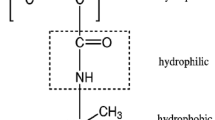Abstract
A sample of poly(ε-caprolactone) was synthesized and mixed with dimethylformamide to form thermogels. Most of these gels show two endothermic melting events as measured by differential scanning calorimetry. Increasing the annealing temperature and annealing time or decreasing the cooling rate results in the appearance of the low-melting endotherm shifting to higher temperatures and growing in size and the high-melting endotherm shrinking until the two endotherms merge into a single peak. Mathematical simulations of the two endothermic melting events and an exothermic recrystallization event show that the high-melting endotherm remains constant, but a shift to higher temperatures of the low-melting endotherm and exothermic recrystallization results in the appearance of the low-melting endotherm growing in size and the high-melting endotherm shrinking. These results suggest two distinct crystallite populations. Additional evidence of the different populations of crystallites was provided through partial melting experiments. The melting behavior of a given set of annealing parameters is reproducible, but changing the annealing parameters can result in a very different melting behavior for the thermogels.














Similar content being viewed by others
References
Guenet JM. Thermoreversible gelation of polymers and biopolymers. London: Academic Press; 1992.
Guenet JM. Polymer–solvent molecular compounds. Oxford: Elsevier; 2008.
Yang YC, Geil PH. Morphology and properties of PVC/solvent gels. J Macromol Sci Part B Phys. 1983;22:463–88.
Smith P, Lemstra PJ. Ultra-high-strength polyethylene filaments by solution spinning/drawing. J Mater Sci. 1980;15:505–14.
Jeong B, Bae YH, Lee DS, Kim SW. Biodegradable block copolymers as injectable drug-delivery systems. Nature. 1997;388:860–2.
Zhou S, Deng X, Yang H. Biodegradable poly(ε-caprolactone)–poly(ethylene glycol) block copolymers: characterization and their use as drug carriers for a controlled delivery system. Biomaterials. 2003;24:3563–70.
Park MH, Joo MK, Choi BG, Jeong B. Biodegradable thermogels. Acc Chem Res. 2012;45:424–33.
Fu SZ, Guo G, Gong CY, Zeng S, Liang H, Luo F, Zhang XN, Zhao X, Wei YQ, Qian ZY. Injectable biodegradable thermosensitive hydrogel composite for orthopedic tissue engineering. 1: Preparation and characterization of nanohydroxyapatite/poly(ethylene glycol)–poly(ε-caprolactone)–poly(ethylene glycol) hydrogel nanocomposites. J Phys Chem B. 2009;113:16518–25.
Vlierberghe SV, Dubruel P, Schacht E. Biopolymer-based hydrogels as scaffolds for tissue engineering applications: a review. Biomacromolecules. 2011;12:1387–408.
Lee JW, Hua F, Lee DS. Thermoreversible gelation of biodegradable poly(ϵ-caprolactone) and poly(ethylene glycol) multiblock copolymers in aqueous solutions. J Controll Release. 2001;73:315–27.
Bae SJ, Joo MK, Jeong Y, Kim SW, Lee W, Sohn YS, Jeong B. Gelation behavior of poly(ethylene glycol) and polycaprolactone triblock and multiblock copolymer aqueous solutions. Macromolecules. 2006;39:4873–9.
Liu CB, Gong CY, Huang MJ, Wang JW, Pan YF, Zhang YD, Li GZ, Gou ML, Wang KW, Tu MJ, Wei YQ, Qian ZY. Thermoreversible gel–sol behavior of biodegradable PCL–PEG–PCL triblock copolymer in aqueous solutions. J Biomed Mater Res Part B. 2008;84B:165–75.
Zhou S, Deng X, Yang H. Biodegradable poly(ϵ-caprolactone)–poly(ethylene glycol) block copolymers: characterization and their use as drug carriers for a controlled delivery system. Biomaterials. 2003;24:3563–70.
VonRue I, Foreman B, Monaghan J. Thermoreversible gelation of polycaprolactone in dimethylformamide. J Undergrad Chem Res. 2013;12:16–8.
Liu T, Petermann J. Multiple melting behavior in isothermally cold-crystallized isotactic polystyrene. Polymer. 2001;42:6453–61.
Yang I, Liu CY. Real-time SAXS and WAXS study of the multiple melting behavior of poly(ε-caprolactone). J Polym Sci Pol Phys. 2010;48:1777–85.
Dikshit AK, Nandi AK. Gelation mechanism of thermoreversible gels of poly(vinylidene fluoride) and its blends with poly(methyl acrylate) in diethyl azelate. Langmuir. 2001;17:3607–15.
Mutin PH, Guenet JM. Physical gels from PVC: aging and solvent effects on thermal behavior, swelling, and compression modulus. Macromolecules. 1989;22:843–8.
Guenet JM, Lotz B, Wittman JC. Thermodynamic aspects and morphology of physical gels from isotactic polystyrene. Macromolecules. 1985;18:420–7.
Berghmans H, Govaerts F, Overbergh N. Gelation and crystallization of poly(ethylene terephthalate-co-isophthalate). J Polym Sci Pol Phys. 1979;17:1251–67.
Sasaki T. Melting of poly(ε-caprolactone) studied by step-heating calorimetry. J Therm Anal Calorim. 2013;111:717–24.
Asplund JOB, Bowden T, Mathisen T, Hilborn J. Variable hard segment length in poly(urethane urea) through excess of diisocyanate and vapor phase addition of water. Macromolecules. 2006;39:4380–5.
Lescanne M, Colin A, Mondain-Monval O, Fages F, Pozzo J-L. Structural aspects of the gelation process observed with low molecular mass organogelators. Langmuir. 2003;19:2013–20.
Vikki T, Ruokolainen J, Ikkala OT. Thermoreversible gels of polyaniline: viscoelastic and electrical evidence on fusible network structures. Macromolecules. 1997;30:4064–72.
Stoks W, Berghmans H, Molenaers P, Mewis J. Thermoreversible gelation of solution of poly(vinyl alcohol). Polym Int. 1988;20:361–9.
Prasad A, Mandelkern L. The thermoreversible gelation of syndiotactic polystyrene. Macromolecules. 1990;23:5041–3.
Phillipson K, Jenkins MJ, Hay JN. The kinetics of crystallization of poly(ε-caprolactone) measured by FTIR spectroscopy. J Therm Anal Calorim. 2016;23:1491–500.
Acknowledgements
The authors are thankful to J. Belanger and R. Supkowski for their feedback on this research and the King’s College Chemistry and Physics Department for providing funding. This research is based upon work supported by the National Science Foundation under CHE-1337137.
Author information
Authors and Affiliations
Corresponding author
Rights and permissions
About this article
Cite this article
VonRue, I., Conway, J.C. & Kline, D.J. Differential scanning calorimetry study of the impact of annealing conditions on poly(ε-caprolactone) thermogels. J Therm Anal Calorim 128, 465–474 (2017). https://doi.org/10.1007/s10973-016-5948-y
Received:
Accepted:
Published:
Issue Date:
DOI: https://doi.org/10.1007/s10973-016-5948-y




